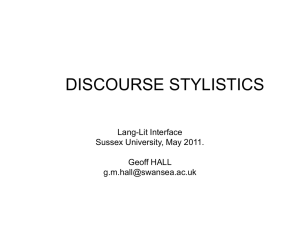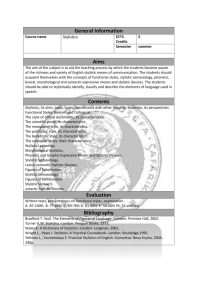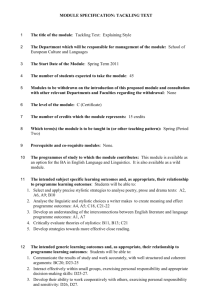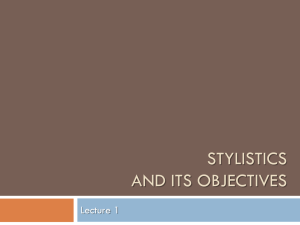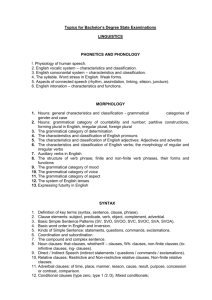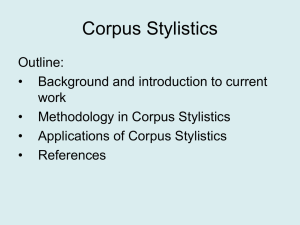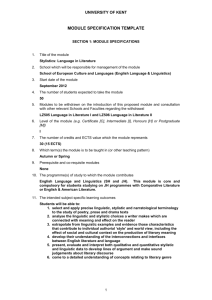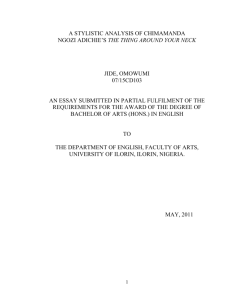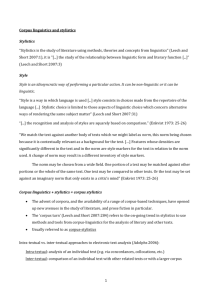اسم الدكتور: فاطمة عبد الصمد محمد الشافعي اسم المادة: علم الاساليب اسم
advertisement
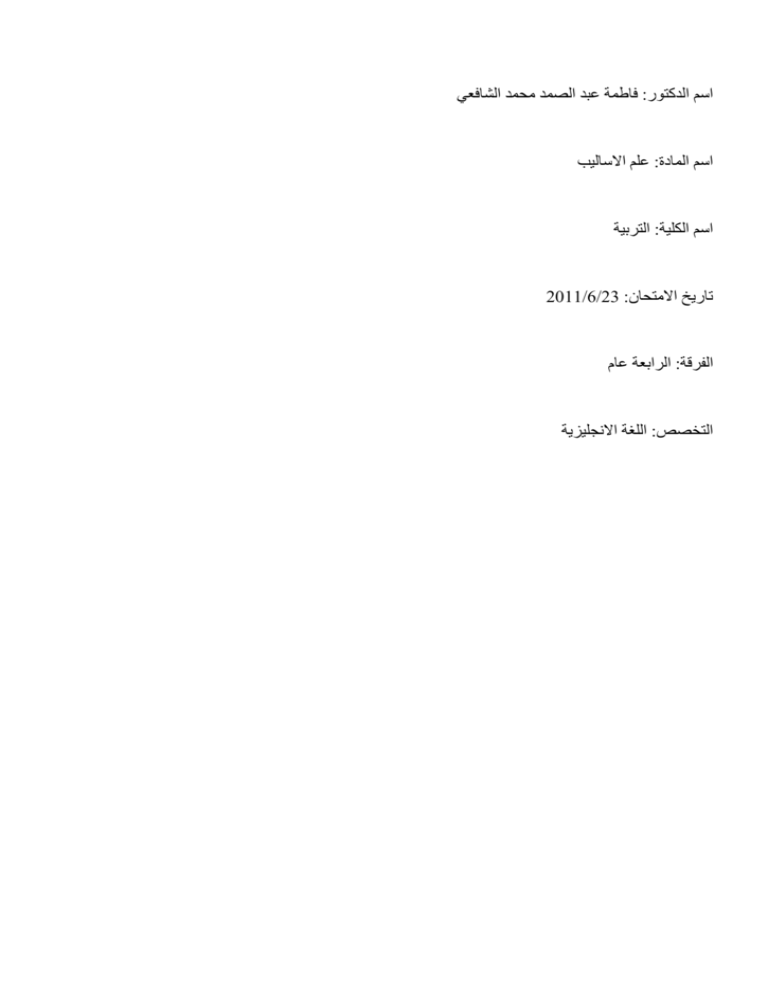
اسم الدكتور :فاطمة عبد الصمد محمد الشافعي اسم المادة :علم االساليب اسم الكلية :التربية تاريخ االمتحان2011/6/23 : الفرقة :الرابعة عام التخصص :اللغة االنجليزية Write to explain, discuss and elaborate on ONE only of the following: 1.“During the second half of the twentieth century. More specifically in the last two decades, stylistics has been a productive interdisciplinary science combining both linguistic and literary studies.” (El-Shafey, 2004) Explain and discuss. During the second half of the twentieth century, more specifically in the last two decades, stylistics has been a productive interdisciplinary science combining both linguistic and literary studies. Stylistic studies undertook theoretical frameworks derived from transformational generative grammar inaugurated by Noam Chaomsky in 1957, functional grammar founded by M. A. K. Halliday in 1961, pragmatic theories of communication initiated by John Austin in 1962 and developed by other pragmaticians and discourse theoreticians headed by names like Ross, Wodack and others. As they have been receptive to changes in the linguistic theory, stylistic studies have also been interacting with the philosophical and literary movements which were successively and alternatively dominant during that period—Russian formalism, North American and European modernism, postmodernism, etc. There are two main implicit assumptions that the trends traceable in stylistic studies are indicators of the circular development of this science and that the former distinction between linguistic and literary stylistics is almost vanishing and they are becoming complementary as a result of the increasingly inevitable interdisciplinarity which stylistics, like many other sciences has witnessed during the second half of the twentieth century. 1. What is stylistics? The above decontextualized quotations indicate the difficulty of defining stylistics as it all depends on the borderlines drawn by stylistcians depending on the purposes of their taken jobs. Stylistics however, has been defined in relation to either stylistic practice or disciplinary arguments. 1.1. Stylistics as the study of ‘style’ All definitions of stylistics are summarized in the tautological non-explanatory statement, which represents a point of departure to all stylisticians—“Stylistics is the (linguistic) study of style” (Bally, 1909). Style is traditionally defined as “…the dress of thought” (Wesley, 1700 [cited in Leech and Short, 1981:18]). It is also used to mean, among other things, a set of choices from among the optional elements of language (Bloch 1953); “…the result of the writer’s choice between synonymous expressions… the aggregate of the contextual probabilities of its linguistic items” (Enkvist, 1964: 1-56). It also meant “…all of the language habits of one person as when we talk of Shakespeare’s style….” ( one of four in Crystal and Davy, 1969: 15); “…expressive or emotive element of language which is added to the neutral presentation of the message itself” (Bally and Riffaterre’s as cited in Leech and Short, 1981:18); “…The connotative level of language-use, as distinctive from the denotative level” (Hickey, 1989: 6); “the art of producing sentences and words that will make a favorable impression on readers or listeners” (Covino and Jollife, 1995); “…the selection of certain linguistic forms or features over other possible ones” (Thornborrow and Wareing, 1998: 3). All these definitions, as well as others, suggest that what is meant by style is usually determined by the purpose of the definition and by the area of interest of the definer. The names and dates associated with the definitions imply that stylistics as the study of style is as old as antiquity and as developmentally surviving as any other science can be. 1.2. Stylistics as an academic discipline The academic discipline of stylistics is argued to be “older than grammar and linguistics proper as, being a part of rhetoric” (Enkvist, 1986:21). Stylistic disciplinary studies gather around two main areas of interest: (1) stylistics as branch of linguistics or of literary studies mainly criticism; and (2) the now undoubted usefulness of stylistics as an academic science pedagogically made use of in the process of teaching literature and composition. The affiliation question remained to be controversial. One of the compromising definitions of stylistics saw it as “…the study of literary discourse from a linguistics orientation. …(it) involves both literary criticism and linguistics as its morphological make-up suggests: the ‘style’ component relating it to the former and the ‘istics’ relating it to the latter” (Widdowson, 1975:3), which made the problem even more complicated. It is, however, relieving to notice the existence of a growing tendency not to discuss stylistics affiliation among stylisticians. This can possibly be attributed to a conviction that stylistics can be both linguistic and literary in a cooperative rather than disputative manner, a reason that takes us back to Widdowson’s definition. It is, nevertheless, helpful to pretend that such a dispute does not exist or rather to follow Enkvist’s (1986) advice not to attempt to pigeonhole stylistics. In this article, the discussion of the linguistic vs literary stylistics controversy does not exceed an understanding of a situation, which once existed but now almost vanished, and which might have been influential in nurturing some of the recent trends in stylistics. 2. Linguistic vs literary stylistics An important issue in the linguistic vs literary stylistics dispute concerned the question whether linguistics can be applied to the study of literary texts (Fowler, 1986). As long as the dispute existed, the distinction between linguistic and literary stylistics was maintained. The original claim for linguistic stylistics or ‘stylolinguistics’, as the famous stylistician Nils Erik Enkvist liked to call it, as the study of style in conformity with some grammar (theory, model) of the language in question (Jakobson, 1961; Lodge, 1966; Enkvist, 1975, 1986) was that it provided a highly illuminating way of doing textual analysis. The main objection to this claim coming from literary stylistics as the study of the aesthetics of literary texts was that the focus on linguistic mechanism paid no attention to literary considerations (Fowler, 1986). Recent stylistics, however, explicitly liquidates this dispute, though an ever-lasting disagreement between linguists and critics concerning this distinction may still implicitly exist. The liquidating process had its roots a long time ago as it was covertly agreed that the ultimate end of text examination is interpretation—the aim overtly expressed by recent discourse stylisticians (Weber, 1996; Carter, 1997). Both text examination and interpretation constitute the discussion of the recent trends in stylistics, most specifically interdisciplinary stylistics. 3. Interdisciplinary stylistics Interactional stylistic studies analyse ways of speaking, e.g. persuasion, negotiations to explain how participants interact. They also analyse the participants’ style of communication within interpretive frames (Gumperz, 1982; Tannen, 1984, 1994). These studies are recognized as branches of stylistics known as: 1. Pragmastylistics 2. Conversational stylistics 3. Text linguistic stylistics 4. Lexical stylistics 5. Computational stylistics 6. Cognitive stylistics 7. Stylistics and hermeneutics Definitions of each of the seven branches can be added with possible examples to the answer *************** 2.“In the history of stylistics, two opposite and equilibrated trends of development representing challenges to stylistics are observable: (1) efforts to expand the field of research; and (2) attempts to constrain or clearly delimit the field.” (Kemeng, 2003) In the history of stylistics, two opposite and equilibrated trends of development representing challenges to stylistics are observable: (1) efforts to expand the field of research; and (2) attempts to constrain or clearly delimit that field (Kemeny, 2003). Both trends can be appreciable perspective for developing this branch of knowledge. The former leads to for trading more domains and yielding more subjects is warrant to make stylistics more complex to the effect of gaining more insight of language usage. The latter calls for getting more depth, more clear-cut definitions of the object and methodology of the stylistic studies. The recent history of stylistics, however, moves more in favor of the former trend. However, this expansion may erroneously be understood as a shift to assimilate in other disciplines: ‘… At the turn of the twentieth century, allegiance to linguistic procedures was the primary defining element of stylistics as a descipline, and it remains so in the last quarter of the century. The major question facing stylistics is whether movement away from that defining characteristic, no matter how slight, will result not only in a loss of self-definition but also in a shifting back of the entire field into the related disciplines of literary criticism, linguistics, or more probably Rhetoric, which is enjoying a strong rebirth.” Catano, 1997: available on line) Enkvist (1986:32) discusses the above stylistics crossroads by attempting to answer a direct and straightforwardly formulated question ‘whether stylistics still exists.’ In his article entitled ‘What has discourse linguistics done to stylistics’, Enkvist proposes two possible answers. First, stylistics could have been swallowed and chewed up in the nutritional process of discourse linguistics. Second, it could have been just hidden by discourse linguistics for a period of maturation and a reappearance in multiple outgrowing ramifications. The former question implies that stylistics has been ‘assimilated’ in other disciplines. The latter which he calls an opinion of a ‘diehard stylistician’ acknowledges the new ‘all-encompassing’ nature of stylistics with text and discourse linguistics as its subdivisions. The newly born branches—text stylistics, discourse stylistics, pragmastylistics, etc.—are all interdisciplinary. Interdisciplinarity is however, not new to stylistics. Stylistics is interdisciplinary by definition (Tan, 2002). The interdisciplinary nature of stylistics is pedagogically made use of (see Holloway, 1981; Kramsch, 1996, Johnson, 2003) to generate different subjects, e.g. stylistics of fiction (Toolan, 1990) stylistics of poetry (Levin, 1962, Short, 1993, 1995), The stylistics of fiction (Leech and Short, 1981 and Toolan, 1990), stylistics of Drama (Culpeper et al 1998; Tan, 2002), etc. These types of stylistic studies have at least two important functions. First, the give insightful explanatory analysis of structures of literary texts as well as their aesthetic functions. Second they are used as tools facilitating teaching literature through either reading or genre analysis at one hand and composition courses at another hand (Swales, 1990). Genre stylistics is as old as stylistics, though is recently done in an interdisciplinary framework. Genre stylistics provides, among other things, interpretive analyses of different types of discourse used for different purposes. This area also overlaps with discourse studies as both are concerned with texts produced in educational, medical, legal, as well as other contexts (e.g. Maher, 1986; Bhatia, 1987, Swales, 1988). Stylistics is also perceived as an interdisciplinary linguistic science which generates work described as literary semantics (e.g. Gibbs 1990; Steen,1994), lexical stylistics (e.g. Lyons, 1963; Cassirer, 1997), discourse stylistics ( e.g. Chatman, 1978; Carter, 1997), pragmastylistics (Hickey, 1989; Pratt, 1977) etc. Stylistics also cooperates with other sciences to the generation of what is recently known as cognitive stylistics (e.g. Freeman, 1995; Semino, 2002), psycho-stylistics (e.g. Wilkinson, 1986; Vice, 1996), computational stylistics (e.g. Bailey, 1990) which are all different linguistic sciences where stylistics represents a major pole. The following is a short discussion of examples of interdisciplinary studies which is by no means comprehensive though intended to be representative. Two types of interdiscip-linary trends are recognized. The first trend represents studies in cooperation with interaction linguistics. The second represents studies in cooperation with other linguistic or non-linguistic disciplines. These studies are recognized as branches of stylistics known as: 1. Pragmastylistics 2. Conversational stylistics 3. Text linguistic stylistics 4. Lexical stylistics 5. Computational stylistics 6. Cognitive stylistics 7. Stylistics and hermeneutics Definitions of each of the seven branches can be added with possible examples to the answer ***************
